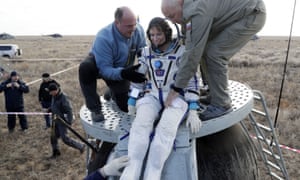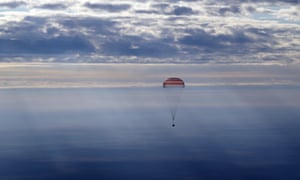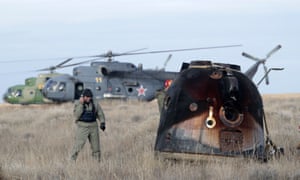Featured Post
- Get link
- X
- Other Apps
Team from US, Russia and Japan land safely in Kazakhstan after two-day journey back from the International Space Station
 Ground personnel help International Space Station crew member US astronaut Kate Rubins to get out of the Soyuz MS space capsule. Photograph: Dmitri Lovetsky/AFP/Getty Images
Ground personnel help International Space Station crew member US astronaut Kate Rubins to get out of the Soyuz MS space capsule. Photograph: Dmitri Lovetsky/AFP/Getty Images
Three astronauts have landed safely in Kazakhstan following a 115-day mission aboard the the International Space Station.
The team included US astronaut Kate Rubins, the first person to sequence DNA in space.
Russian mission control confirmed the touchdown of Nasa’s Rubins, Roscosmos’ Anatoly Ivanishin and Takuya Onishi of the Japan Aerospace Exploration Agency on Sunday morning.

The trio landed south-east of the Kazakh steppe town of Zhezkazgan in clear but frosty conditions after a flight from the orbital lab.
“Landing has taken place!” Russian mission control stated, with commentators on Nasa TV noting that the Soyuz craft had landed in an upright position.
Molecular biologist Rubins and Onishi were both returning from their first missions in space, while flight commander Ivanishin undertook a five-month mission at the ISS five years ago.
 Russias Soyuz MS space capsule carrying the International Space Station crew prepares to touch down in a remote area of Dzhezkazgan. Photograph: Dmitri Lovetsky/AFP/Getty Images
Russias Soyuz MS space capsule carrying the International Space Station crew prepares to touch down in a remote area of Dzhezkazgan. Photograph: Dmitri Lovetsky/AFP/Getty Images
Footage from the landing site on Nasa television showed Rubins smiling after she was hoisted out last from the Soyuz descent module.
“Everybody is feeling wonderful,” said Ivanishin, who emerged first from the craft, in comments translated from Russian.
After they are flown to the Kazakh city of Karaganda, Ivanishin will head to Star City just outside Moscow for post-mission work, while Rubins and Onishi will fly to Houston.

Ground personnel help International Space Station crew member Japanese astronaut Takuya Onishi out of the capsule shortly after the landing. Photograph: Dmitri Lovetsky/AFP/Getty Images
Rubins was the first woman aboard the ISS since Italian Samantha Cristoforetti returned to Earth with the record for the longest single spaceflight by a woman (199 days) in June last year.
Fellow American Peggy Whitson, 56, will blast off to join an all-male crew at the lab with French astronaut Thomas Pesquet and Russian cosmonaut Oleg Novitskiy from the Baikonur cosmodrome on 17 November.
The blastoff was delayed by 48 hours as Russian space officials sought better docking conditions.Whitson is NASA’s most experienced female astronaut and will command the ISS for the second time after becoming the first female commander of the station on her second space mission back in 2007.
 Ground personnel help International Space Station crew member US astronaut Kate Rubins to get out of the Soyuz MS space capsule. Photograph: Dmitri Lovetsky/AFP/Getty Images
Ground personnel help International Space Station crew member US astronaut Kate Rubins to get out of the Soyuz MS space capsule. Photograph: Dmitri Lovetsky/AFP/Getty ImagesThree astronauts have landed safely in Kazakhstan following a 115-day mission aboard the the International Space Station.
The team included US astronaut Kate Rubins, the first person to sequence DNA in space.
Russian mission control confirmed the touchdown of Nasa’s Rubins, Roscosmos’ Anatoly Ivanishin and Takuya Onishi of the Japan Aerospace Exploration Agency on Sunday morning.

The trio landed south-east of the Kazakh steppe town of Zhezkazgan in clear but frosty conditions after a flight from the orbital lab.
“Landing has taken place!” Russian mission control stated, with commentators on Nasa TV noting that the Soyuz craft had landed in an upright position.
Molecular biologist Rubins and Onishi were both returning from their first missions in space, while flight commander Ivanishin undertook a five-month mission at the ISS five years ago.
 Russias Soyuz MS space capsule carrying the International Space Station crew prepares to touch down in a remote area of Dzhezkazgan. Photograph: Dmitri Lovetsky/AFP/Getty Images
Russias Soyuz MS space capsule carrying the International Space Station crew prepares to touch down in a remote area of Dzhezkazgan. Photograph: Dmitri Lovetsky/AFP/Getty ImagesFootage from the landing site on Nasa television showed Rubins smiling after she was hoisted out last from the Soyuz descent module.
“Everybody is feeling wonderful,” said Ivanishin, who emerged first from the craft, in comments translated from Russian.
After they are flown to the Kazakh city of Karaganda, Ivanishin will head to Star City just outside Moscow for post-mission work, while Rubins and Onishi will fly to Houston.
A Russian Soyuz MS space capsule rests on the ground after landing. Photograph: Dmitri Lovetsky/AFP/Getty Images
Their journey back to Earth marks the first complete mission to and from the orbital lab for a new generation of Soyuz spacecraft with upgraded features.
The trio’s arrival at the ISS was delayed by two weeks as Russian space officials carried out further software tests on the modified Soyuz MS-01 vehicle.
Rookie Rubins’s participation in the mission generated particular excitement after Nasa announced plans for the career scientist to sequence DNA aboard the ISS in a world first.
In August, Rubins successfully sequenced samples of mouse, virus and bacteria DNA using a device called MinION while Earth-based researchers simultaneously sequenced identical samples.
Nasa said the biomolecule sequencer investigation could help to identify potentially dangerous microbes aboard the ISS and diagnose illnesses in space.
Their journey back to Earth marks the first complete mission to and from the orbital lab for a new generation of Soyuz spacecraft with upgraded features.
The trio’s arrival at the ISS was delayed by two weeks as Russian space officials carried out further software tests on the modified Soyuz MS-01 vehicle.
Rookie Rubins’s participation in the mission generated particular excitement after Nasa announced plans for the career scientist to sequence DNA aboard the ISS in a world first.
In August, Rubins successfully sequenced samples of mouse, virus and bacteria DNA using a device called MinION while Earth-based researchers simultaneously sequenced identical samples.
Nasa said the biomolecule sequencer investigation could help to identify potentially dangerous microbes aboard the ISS and diagnose illnesses in space.

Ground personnel help International Space Station crew member Japanese astronaut Takuya Onishi out of the capsule shortly after the landing. Photograph: Dmitri Lovetsky/AFP/Getty Images
Rubins was the first woman aboard the ISS since Italian Samantha Cristoforetti returned to Earth with the record for the longest single spaceflight by a woman (199 days) in June last year.
Fellow American Peggy Whitson, 56, will blast off to join an all-male crew at the lab with French astronaut Thomas Pesquet and Russian cosmonaut Oleg Novitskiy from the Baikonur cosmodrome on 17 November.
The blastoff was delayed by 48 hours as Russian space officials sought better docking conditions.Whitson is NASA’s most experienced female astronaut and will command the ISS for the second time after becoming the first female commander of the station on her second space mission back in 2007.

Comments